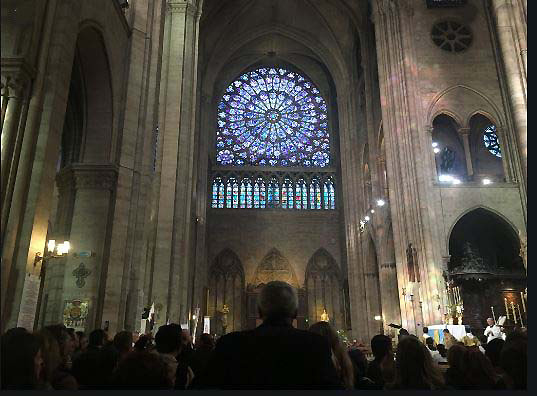NEXT ALONG THE ROUTE, A CHURCH WHERE THE KING REPLACES JESUS
(SAINT PAUL-SAINT LOUIS)
The speed of construction shows its importance: Saint Eustache, the last "Gothic" church started almost a century before, was still unfinished when the new worksite began.
(Saint-Louis, 1626-41; Saint-Eustache, 1532-1632)
Adapted from a plan of 1734 / zoom
Toward 1820 / zoom
# # #
The church and monarchy:
- The double name: Napoleon added "Saint-Paul" to the original "Saint-Louis" to lessen the link with monarchy.
All French kings descend from Saint Louis, a stupefying advantage. But the preceding dynasty (the Valois) did not emphasize it, because it lacked the power to live up to such an ancestor.
All the Bourbon kings are named "Louis." So are many women, bastards, cousins —
- Anne-Marie Louise, who fired on the royal troops;
- Louis-Antoine, eldest of Louis XIV's legitimized sons;
- Louis XVI's sons, Louis-Joseph and Louis-Charles;
- Louis-Philippe, head of the Bourbon junior branch, whom the royalist Chateaubriand calls only Philippe because he is a usurper.
Louis XX is head of today's Bourbons of Spain. His name forbids him from residing in France.
# # #
Saint-Louis Saint-Paul marks the end of Gothic architecture and start of baroque: Comparing it with Notre-Dame shows the tie between a monument's tangible aspects and its message:
- Surroundings
- Eternity
To see Notre-Dame as whole one had to come close to the facade and peer up. Then it loomed over daily life, reminding of immortality. To do so at Saint-Louis, one had to stand in the street and risk being run over. (The photo above shows the modern sidewalk that barriers separate from the street.)
Medieval stained glass windows brought colored light that by gleaming through the gloom foreshadowed the next world, an impression that was much more powerful without electricity. In the 17th century, daylight enhanced secular grandeur.
- The Resurrection
The entry to Gothic churches is in the west, the chevet (the sanctuary) in the east: One passes from the setting sun and death to the rising son and resurrection. But Saint-Louis faces north.
- Heaven or earth?
- The Last Judgement and Salvation
Last Judgments are sculpted over the entries of Gothic churches. Multitudes, which originally were brightly painted, surround Jesus. All are invited to enter and be saved:
Ramsay Casadesus Rawson
Basilica di Santa Caterina d'Alessandria in Galatina, Italy, late 14th century.
# # #
Carlton Perrett
For the kings themselves, being God's representative brought desolation.
Louis XIV found the role "delicious" but it overwhelmed his father and successors.
Louis XIII thought himself inadequate to the task, a feeling that contributed to his stuttering and ill health. Louis XV hated the public existence royalty imposed and by avoiding it hastened its demise. Louis XVI's library shows his vocation of science.
# # #
Saint-Louis took up the Rome's style of Counter-Reformation and became the model for the churches of its day:
 |
| Il Gésu / zoom |
Saint-Thomas d'Aquin, first stone 1632 ; Saint-Roch, 1653; Saint-Sulpice 1646
With no eternity, no Last Judgement,
a crucifix one can hardly see
a crucifix one can hardly see
and emphasis on the king instead of Jesus,
the new church announces
that salvation depends on obeying the king.
the new church announces
that salvation depends on obeying the king.
These churches herald
* * *
Next,








.jpg)














No comments:
Post a Comment